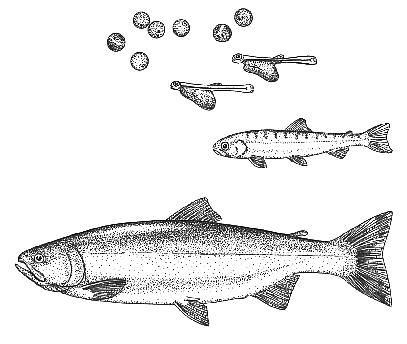There
are well known populations of a truly
freshwater form of this species, the kokanee,
as well as the anadromous sockeye salmon.
The kokanee is generally very similar
to the sockeye except in ultimate length
and weight.
DESCRIPTION
- The streamlined body of this species
is usually 8-9 inches long when mature.
(A sockeye is about 24 inches long when
it returns to freshwater.) The head is
bluntly pointed and conical with a pointed
snout and small teeth on the jaws. Breeding
males have a more compressed head and
body with a prolonged, hooked, turned
up snout and a small hump before the dorsal
fin. Breeding males and females experience
a striking color change. Typical coloring
of this species is a brilliant steel-blue
to green-blue with no distinct spots and
sides an overall bright silver with a
white to silver belly.
DISTRIBUTION
- The kokanee is found over most of the
range of the sockeye salmon which extends
in North America from the Klamath River
in California to Point Hope, Alaska. The
kokanee occurs naturally in Japan, USSR,
Alaska, Yukon Territory, British Columbia,
Washington, Idaho and Oregon but they
are more widely found and abundant in
British Columbia.
BIOLOGY
- Kokanee spawn in the fall from September
to October. The mature adults usually
enter inlet streams of the lake in which
they are living or they may spawn in gravel
beds along its shore. The female prepares
the nest and lays 368-1764 (average 450)
eggs where a few days to several weeks
later the adults of both sexes die. Hatching
occurs in December-January and emergence
is not until March-May. Generally this
species mature, spawn and die at 4 years
of age. Kokanee as large as 21 inches
in length and weights of up to 4 pounds
are not uncommon. In the anadromous sockeye
spawning takes place from July to December
mainly from the Fraser River to drainages
into Bristol Bay.
RELATION
TO MAN - Kokanee have long since been
a sport fish of interest. They are generally
looked upon as hard to catch by anglers
as this species are plankton feeders.
Both Kokanee and Sockeye are considered
excellent sportfish which eagerly take
both flies and lures. Their flesh is often
blood-red, oily and delicious cooked in
a variety of ways, or brined and hot smoked.
Canning is also a popular method of preservation.




